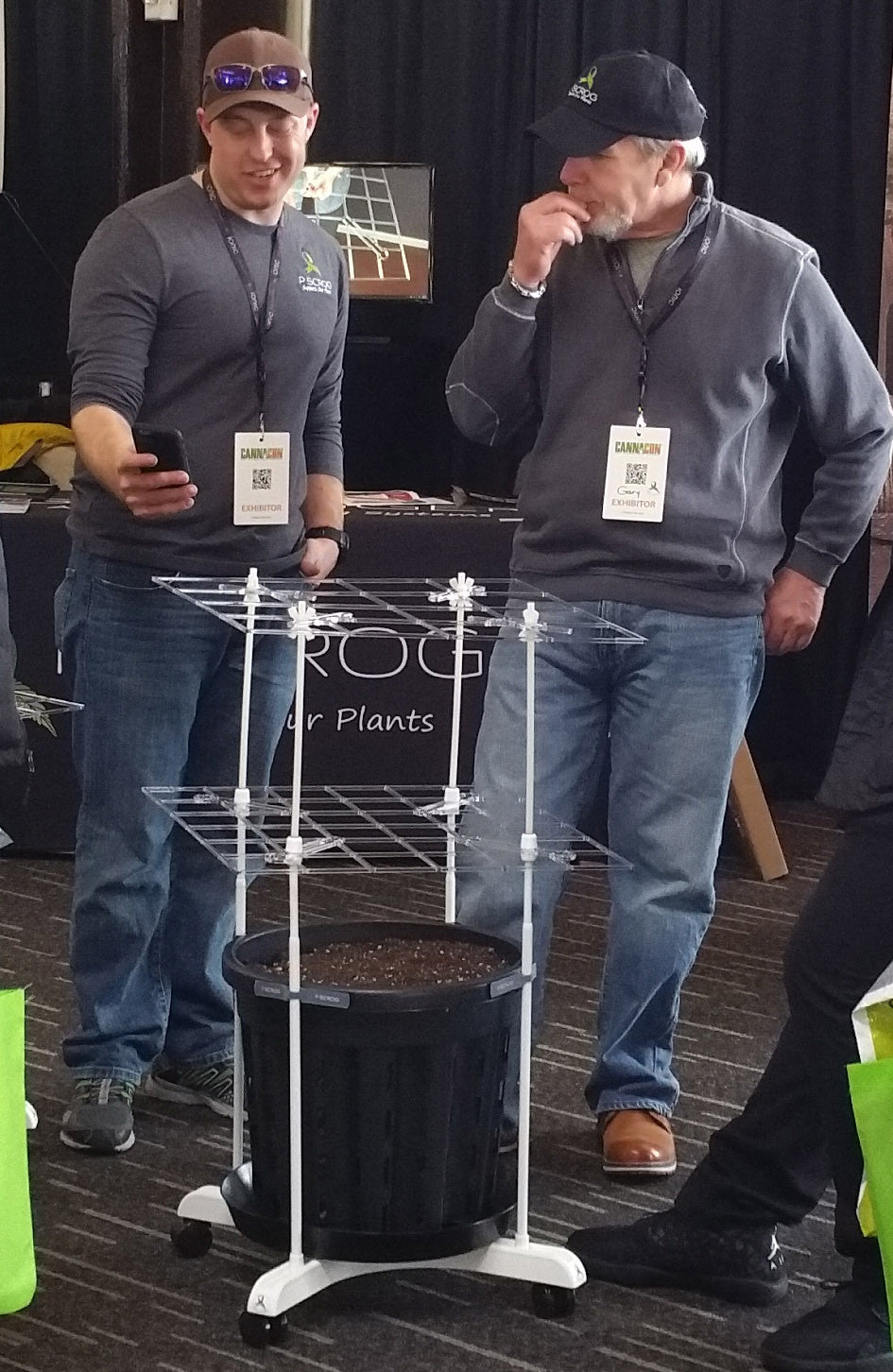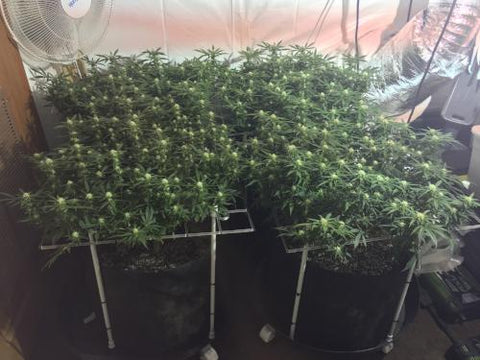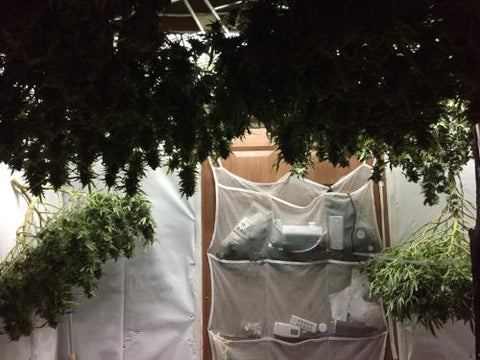ScrOG blOG™ — cannabis defoliation

The Denver Defoliator
Mike didn't seem like the abusive type when I first met him at Indo Expo in Denver. ...until he showed me what he does to his plants!!
Mike (L) & Gary (R)
4 of Mike's defoliated plants in P SCROGs
Gary - So we're talking about Defoliation and to be quite frank with you, I had never even heard of defoliation prior to you bringing it up. ...pruning and trimming yes, defoliation, no. Although I acted like I knew what you were talking about, it wasn't until our second conversation did I ask you, "what the heck are you talking about?"
Mike - Defoliation is simply removing leaves from parts of the canopy. Everybody has the tendency or urge to do this when they see a yellow leaf or a leaf that's not doing well or a leaf that clearly has a bug on it. They are very quick to pluck that leaf from the plant to discard it in the trash. But defoliation in regards to increasing cannabis yield means being more aggressive at removing leaves from the canopy. Not just removing the growth that's struggling but removing new growth and bushy growth to help get light penetration to the lower canopy. Leaf removal helps when utilizing some of the newer lighting technologies like LEDs. Fewer leaves promotes air circulation, helps plants breathe and helps to prevent issues with powdery mildew where you've got damp leaves touching one another. It gives the plant a little bit more opportunity for growth because you're giving it better conditions. The reality is Mike is a gentle man and one great indoor gardener! And like most great gardeners, he pushes the limits of experimentation with his plants with such techniques as defoliation. He's really not abusive at all.
When I Googled defoliation what I found was that the technique as it applies to cannabis is quite controversial (see growweedeasy.com). So, I asked Mike if he would demystify the technique for me and for readers of the ScrOG blOG in the following interview.
Gary - A lot of people lollipop, remove fan leaves and prune here and there but it seems that the defoliation technique is much more aggressive at leaf removal. When you showed me the pictures I was shocked. There were hardly any leaves left!
Mike - Absolutely, the way I like to do it is in the first week of flower I cut every leaf that I can get scissors to on the stems. I don't really work to get the tiny tiny leaves but I go in and I thin the plant out and I make it super super bare. A lot of people would freak out when they see the plant minus all its leaves.
It takes about 3 days for the untouched little leaves to sprout out and create a full canopy again. I was told that this is merely because of the plant's need for photosynthesis and a need for a leaf to be at the site, It understands when you've pruned it. The plant thinks, "man we don't have much capacity to to do our solar photosynthesis so we need to push out a new set of leaves" and in that way it kind of forces a quick new growth and it bounces back healthier when you knock it down a little bit.
Gary - So to me it's kind of counterintuitive. You need the leaves to absorb the light to produce flowers, yet you're removing those leaves.
Mike - That was a concept that I had difficulty grasping also and I have got to tell you I don't currently know the science behind the technique. I just know that it works.
The best answer, and this is just a total guess, is that while you've removed all its leaves and the little baby ones are there, the plants are like maybe twenty four to forty eight hours behind. You have stunted it and you have taken its leaves but its stalk, its roots and its processes are already determined. It has already told those little leaves to grow. They are already on their way to fruition and it's kind of like nothing you do stops that from happening. And a few days later, you have got a full canopy.


Gary - When you first told me about this I went online and I started doing some research. I found there are some hardcore advocates, but there are also adamant opponents of the method.
Mike - Yeah you can mess it up. I mean clearly anybody who has worked with their plants more than just putting them in a pot and letting them grow; anybody who has gone in there and tried to bend the branches out or remove growth or low stress train their plant in any way, knows they always have the potential break the plant. You may break a stem, or even worse break the main stalk while manipulating it.
A lot of people who are clumsy you know and don't trust themselves worry about breaking their plant and that is a true concern. Some people worry about over stressing their plants. For new growers or people who bring a plant into the space that's unhealthy, that is a serious concern as well because their plants might not be able to tolerate the stress, the training and the removal of leaves and branches like a fully healthy plant with great root mass and in prime condition. So you definitely want to bring a plant to the table that has no diseases or other problems and is a very healthy grower. You can also defoliate too often and mess up the internodal spacing causing the plant to stack.
Gary - How often do you defoliate during a plants life cycle?
Gary - How often do you defoliate during a plants life cycle?
Mike -I try to defoliate three times at most. Once during vegetative cycle, usually somewhere in the 8 to 12 week range, around the time I am topping the plant. The second time is in the first week of flower and the third at around 18 to 21 days of flower. I find that it really helps with the bugs because there's nowhere for them to live. It helps with light penetration and helps stimulate auxin production, the hormonal response forcing the plant to grow.
Gary - Just about everything we do to a plant we do to increase the yield. I would assume that is the same goal with defoliation. Since the end goal is to increase yield you must really believe in the technique.
Gary - Just about everything we do to a plant we do to increase the yield. I would assume that is the same goal with defoliation. Since the end goal is to increase yield you must really believe in the technique.
Mike - I don't necessarily do it for the increase in yield. I believe it improves the uniformity of buds. So by defoliating hardcore and lollypopping the lower branches that we're going to be a little shaggy and larfy anyways, we are telling the plant where to focus its energy. We're kind of bonsai instructing the plant. That puts more growth into the bud sites that were selected so they will be larger and more uniform in their appearance. We don't end up dealing with the smaller popcorn that would have grown there. I can get to my weight a lot easier and it's going to be a lot more attractive. For me it is more about quality of final product and usable bud weight...dense uniform buds.
Gary - Is everything below the screen kept clean? I know you use the P SCROG. How does defoliation work with the P SCROG?
Mike - Everything below the screen is clean for sure.

The P SCROG makes execution of all the techniques simpler. I put the plant in the P SCROG without the screen in early veg, then top it 2 to 3 times to create 4 to 6 main branches. When the plant reaches 10 to 12 inches tall I apply the lower training screen and flatten the canopy using low stress training with the main branches spreading under the screen symmetrically. I defoliate the plants while in the P SCROG 3 times according to the schedule I mentioned earlier. Lollipopping occurs as soon as the screen is applied and I continue to remove any new growth below the screen as soon as I see it for the rest of the plant's life. Anytime plant tips try to grow through the screen they are tucked and weaved back under the scree with the objective of creating a flat canopy. The flat screen ensures that all selected bud sites fall within the most effective lighting zone.
Since each plant is in its own P SCROG and is on casters, accessibility to perform all techniques effectively is a dream come true compared to how I used to struggle with all plants under the same fixed ScrOG.
At harvest, I cut the main stalk and remove the screens, leaving the canopy in tact. I prefer to dry trim, so I hang the screens with canopies on hooks to dry and immediately put the unit back into production with a second set of primary screens.
With this method I get 5 grows a year per P SCROG bringing down my investment expense to just a few bucks per grow and at the same time giving me more usable and esthetically appealing bud.
Gary - Last time we visited Mike in Denver he turned me on to some of his "Green Crack" he grew with love and using all the techniques he shared in this blog. That bud was one of the prettiest I have ever seen and the quality of the taste, smell and high would rival some of the best Leafly reviews.
So as odd as defoliation may seem to some people, it's one more discipline one might want to consider in the quest to grow better and better weed.
Mike, thank you so much for sharing your knowledge in this ScrOG blOG.
Mike - Thank you also.


MAXIMIZE YIELD
with
P SCROG Kits
P SCROG support 7 days a week - 512-528-6028
or
SupportOurPlants@SCROGGER.com
or
SupportOurPlants@SCROGGER.com




